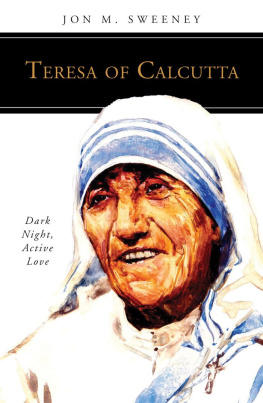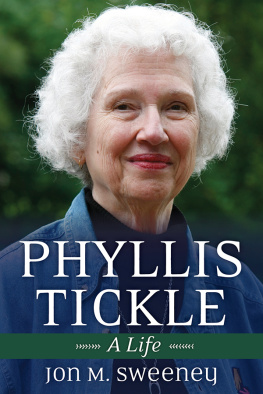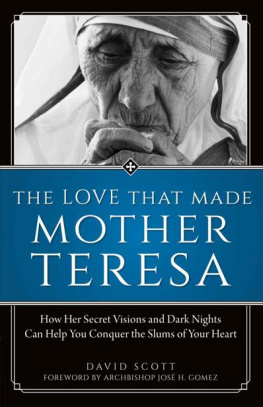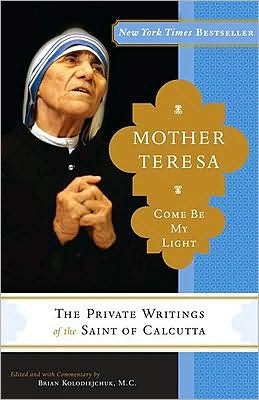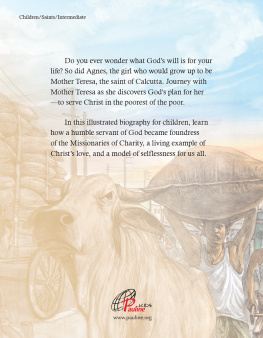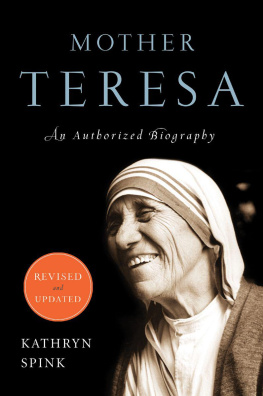Cover design by Red+Company. Cover illustration by Philip Bannister.
2022 by Jon M. Sweeney
Published by Liturgical Press, Collegeville, Minnesota. All rights reserved. No part of this book may be used or reproduced in any manner whatsoever, except brief quotations in reviews, without written permission of Liturgical Press, Saint Johns Abbey, PO Box 7500, Collegeville, MN 56321-7500. Printed in the United States of America.
Library of Congress Control Number: 2022934166
ISBN 978-0-8146-6615-9 978-0-8146-6639-5 (e-book)
If we pray, we will believe.
If we believe, we will love.
If we love, we will serve.
St. Teresa of Calcutta
Introduction
Most human beings living in the last quarter of the twentieth century knew Mother Teresa by name and appearance. Most people on the planet could identify her as the saint of the gutters of Calcutta. She was regularly named as one of the most recognized and influential people in the world. International polls ranked her beside Billy Graham as one of the most popular religious figures. Good Housekeeping magazine, in 1980, had her atop their list of the worlds most admired women, an honor captured the previous year by the singer, antigay rights activist, and Evangelical Christian Anita Bryant. Two years after her death, she topped a CNN/USA Today Gallup Poll as the most admired person of the century ahead of Dr. Martin Luther King Jr., President John F. Kennedy, Albert Einstein, and Helen Keller.
So, what really is there still to say about her? Quite a bit, as it turns out. The stories of both her public and private lives remain little known. We also continue to grapple with the extraordinary things she did, as well as the way that she interpreted the vocation of any would-be follower of Jesus.
Perhaps not quite as universally familiar as it was when she was alive, her striking physical appearance remains vivid in the memories of those who were adults then. It always included the sarithe traditional outer garment of women of the Indian subcontinentthat shed chosen as the religious uniform of the congregation she founded in 1950: simple white cotton bordered with three blue stripes. She had apparently purchased the first ones off the rack at a Calcutta market, the blue edges suggesting to her the Virgin Mary.
She was small in stature, but fiercely strong and always determined. Do an internet search and you will find not a single photograph of her appearing weary, winded, or (outside of moments of prayer) at rest. Yet when we saw her ubiquitous face or watched her at work with children and the dyingwhich was easy to do, since she was the first great saint in the era of ubiquitous televisionwe had no idea of the things going on within her that we would learn after her death.
Her surroundings in Calcutta were central to her life and her story. Images of the women, men, and children of that citys streets were familiar. They lay there, destitute, malnourished, and very much alone, even if they were lying near others. Then a tiny woman in a white and blue sari and sandals would bend over to greet them, one by one. She reached out a hand and touched an arm or a shoulder. That is St. Teresa of Calcutta, or Mother Teresa, as the world still most often remembers her, making her daily rounds.
Other things become clear if you study the photographs or look closely at the videos and documentaries. She had large hands for a woman her size. Mother Teresa was tiny. She stood a mere five feet tall in sandals. For comparison, the diminutive Gandhi was five feet five inches. Her hands were thick, coarse, working hands, and she was a hugger, particularly with infants and toddlers. She would pull children tightly to her cheek, one arm underneath the torso, the other propping up the neck, the way a natural mother holds a child. A joyous smile was common on her face. She used to instruct her fellow Missionaries of Charity, When I see someone sad, I always think, she is refusing something to Jesus. Yet she was a serious saint, fiercely dedicated to living her calling, and the same face that bore easy smiles was also marked often by a furrowed brow and pursed determination around the lips.
The images are difficult to forget and easy to find, and her story is so well known that we dont really know her.
Mother Teresa died in 1997. When the United Nations Secretary General Javier Perez de Cuellar introduced Mother Teresa before the organizations general assembly, he called her the most powerful woman in the world. And in her last decades, there were photographs of her and framed quotations by her on the walls of the very Home for the Dying in Calcutta where she lived and worked every day. That must have been strange: to minister with such selflessness while surrounded by images of your own fame.
Active Love, Dark Night
To the intuitive sensibility of the Catholic faithful, Mother Teresa is revered, and her role as an advocate in heaven unquestioned, in the way that only a few other saints of the twentieth century, such as Therese of Lisieux and Padre Pio, have been regarded. She holds a unique distinction, however, as the first great saint of the television age. We came to know her through electronically and digitally transmitted video images, and as such, we felt we knew her in a way that we could not have known any of the saints before her. Through television, we made sense of Mother Teresa, often in real time. The inspiration she took from the words of St. Therese of Lisieux, to be little for God, became more powerful when we saw itand we saw it oftenin action.
We were aware of her activities and movement and influence, as well as the immense compassion she gave to those whom she aided. All of this was more vivid and immediate to people around the globe through the powerful communications technology of the day. Television has made saints in ways not unlike how they were made in the premodern era, when popular acclaim among the populus Dei is what often determined canonical status: the people of God simply demanded it. In Mothers case (and we will often refer to her simply as Mother), prayers for her intercessionif we had statistics for such thingsprobably outstripped every other saint before her by a multiple of ten. For all of these reasons, in contrast to many earlier biographies of her, I will often be using televised interviews and video accounts as sources to tell her story.
One other aspect of this short biography that is perhaps different from others you have read or seen is an awareness of the significant role of the other most important Catholic of the twentieth century, Pope John Paul II, in shaping the Mother Teresa we came to know. His fatherly presence in her life, his own ubiquity in the global communications media, his devotion to the promotion of living embodiments of faith, and the priority he made in his papal ministry of promoting saints and sainthoodall of these things, in significant measure, helped to make Mother into who she was and is.
In these pages we will often call her simply Mother because that is what her fellow Missionaries of Charity sisters and those who knew her best, including people on the streets of Calcutta, most often called her. She often signed her letters with that single word and often referred to herself in the third person that way. For all these reasons, although she is now more formally St. Teresa of Calcutta, to many in the world she will always be simply Mother Teresa, or Mother.
There is another important thing to mention here before we get started. Despite all the evidence we had in front of us while she was alive, it is safe to conclude that, nearly a decade after her official canonization and a quarter century after her death, her reputation is still being sorted out. We are learning new things all the time. That is another reason for this new book introducing her life.

